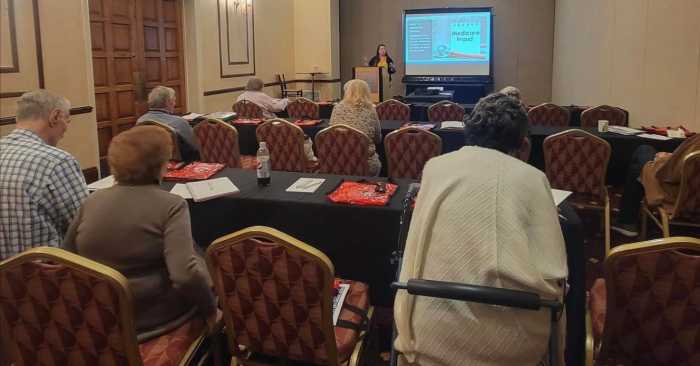The Village of Manorhaven Board of Trustees voted unanimously Wednesday night, Aug. 27, to approve a one-year building moratorium while officials begin work on a long-awaited comprehensive plan and potential zoning changes.
The 5-0 vote followed months of public debate and years of concern from residents about what they call overdevelopment, infrastructure strain, and the character of the densely populated waterfront community.
Residents first called for a moratorium when the Board of Trustees was presented with a mixed-use development proposal for 30 Sagamore Hill Drive. The proposal included a three-story, 49-unit building with 98 underground parking spaces and 31 on-street parking spots along Sagamore Hill Drive and Yennicock Avenue.
During the June Board of Trustees meeting, the board approved the site plans for 30 Sagamore Hill Drive, despite an outcry from residents.
The moratorium will “temporarily suspend land development, construction of buildings and structures, and changes in the use of residential property while the village of Manorhaven considers changes and adopts amendments to its land use regulations in the C-1, C-2, C-3, I-1, I-2, I-3, E-1 R-3, R-4, and the business overlay district zones.”
There are exceptions to the moratorium that include construction of a single-family home, installation or removal of a heating oil or propane tank, and construction undertaken pursuant to a conditional final or final site plan approval prior to the date of adoption of the local law relating to 30 Sagamore Hill Drive.
Mayor John Popeleski said the measure, which could be extended for six additional months, would give the village time to properly study land use and update regulations.
“When I first became mayor, we put a six-month moratorium in place, but nothing came of it,” Popeleski said. “This time we have the proper guidance, resources and professionals to move forward. No administration has taken on what we are doing now, and I’m very proud of this step.”
Despite Wednesday’s vote, the moratorium is not yet in effect. Before becoming law, it must be reviewed by Nassau County, submitted to the state, and filed with the Secretary of State’s office.
Village Attorney Christopher Neumann said the process should take less than a month, but in the meantime, projects currently before the village Planning Board or Board of Zoning Appeals could still receive approvals.

“What happens in the interval is that the Planning board and the BZA are officially not bound by the moratorium yet,” Popeleski said. “But the spirit of the law is there, and I don’t think it will take long.”
He noted that even if applicants secure planning approval before the moratorium takes effect, they may be unable to move forward if a building permit has not yet been issued once the law is officially in place.
Residents who spoke during the hearing overwhelmingly supported the moratorium, though many pressed the board to ensure community voices remain central in shaping the new plan.
Resident Thomas Plominski urged the board to make the process inclusive. “We need everyone to be involved — residents, builders, the school district, engineers, police and fire departments, and business owners,” he said. “Take the passion our community has shown against overdevelopment and let that guide you. The future of Port Washington is in your hands.”

Manhasset Isle resident Christine Zahn thanked trustees for acting after months of public pressure.
“The moratorium is a great step forward for the board and the community,” Zahn said. “But this is only the first step. The end result must be better zoning rules, less reliance on variances, more accountability for builders, and putting community and infrastructure above all else.”
Several residents cited examples of what they called “unscrupulous” developer behavior by developers in Manorhaven.
“This moratorium will help rebuild trust in our local government and put a pause on developers that continue to deceive us,” said resident Christian Hommerich, who described a recent planning board dispute over unapproved bonus rooms. “The consequences cannot just be a fine written off as the cost of doing business.”
Others emphasized the toll of overcrowding and development on local services.
Not everyone supported the new law.
Attorney Sam Epstein, representing Manorhaven property owner Richard Thypin and MBA Manorhaven LLC, objected on behalf of his client. Thypin Steel, a former manufacturing plant at 5 Sagamore Hill Drive. Thypin Steel purchased the site after World War II and operated as a metal fabrication company. In 1999, Island Estates, a Ronkonkoma-based residential developer, signed a contract with Thypin Steel to buy the property on Manhasset Isle to build 96 brand new townhouses on Manhasset Bay, but pollutants in the soil have left the property vacant, even after Thypin spent more than $2 million attempting to remedy the pollutants.
“Our client objects to the adoption of any moratorium or similar law that affects the use, value, marketability, or development of the Typhin property,” Epstein said.

Popeleski hopes the moratorium will allow the village to rethink zoning standards, particularly for two-family homes, which he argues contribute to density issues. He suggests increasing minimum lot sizes for two-family houses to slow development.
“My goal is to have lot sizes be 60 x 100 instead of 50 x 40,” said Popeleski.
According to the U.S. Census Bureau, Manorhaven has a population of 6,956 people in a 0.5 square mile area.
“We are the most densely populated village in the state of New York,” former Manorhaven Mayor Gary Pagano claimed. “How much more crowded can we be? We need to protect our waterfront, maintain water-dependent uses, and make sure the comprehensive plan reflects who we are as a community.”
The mayor pledged to invite public input throughout the process.
“Once we get rolling, I will be reaching out to people for their input,” Popeleski said. “This will take time, but it’s the right path forward for Manorhaven.”
The mayor credited the village’s law firm and the engineering group D&B Engineers and Architects with helping chart a path forward.
The board passed a resolution during the meeting that approved D&B to assist with updating zoning maps, identifying impacted properties, and drafting possible zoning changes. The firm will also prepare a request for proposals to bring in a planning consultant who will lead the comprehensive plan process, which will include public input.



































